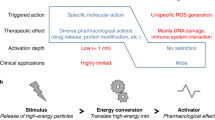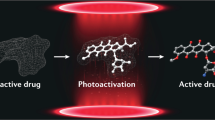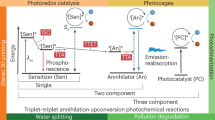Abstract
In photodynamic therapy, light is absorbed by a therapy agent (photosensitizer) to generate reactive oxygen, which then locally kills diseased cells. Here, we report a new form of photodynamic therapy in which nonlinear optical interactions of near-infrared laser radiation with a biological medium in situ produce light that falls within the absorption band of the photosensitizer. The use of near-infrared radiation, followed by upconversion to visible or ultraviolet light, provides deep tissue penetration, thus overcoming a major hurdle in treatment. By modelling and experiment, we demonstrate activation of a known photosensitizer, chlorin e6, by in situ nonlinear optical upconversion of near-infrared laser radiation using second-harmonic generation in collagen and four-wave mixing, including coherent anti-Stokes Raman scattering, produced by cellular biomolecules. The introduction of coherent anti-Stokes Raman scattering/four-wave mixing to photodynamic therapy in vitro increases the efficiency by a factor of two compared to two-photon photodynamic therapy alone, while second-harmonic generation provides a fivefold increase.
This is a preview of subscription content, access via your institution
Access options
Subscribe to this journal
Receive 12 print issues and online access
$209.00 per year
only $17.42 per issue
Buy this article
- Purchase on Springer Link
- Instant access to full article PDF
Prices may be subject to local taxes which are calculated during checkout





Similar content being viewed by others
References
Henderson, B. W. & Dougherty, T. J. Photodynamic Therapy: Basic Principles and Clinical Applications (Marcel Dekker, 1992).
Prasad, P. N. Introduction to Biophotonics (Wiley-Interscience, 2003).
Prasad, P. N. Introduction to Nanomedicine and Nanobioengineering (Wiley, 2012).
Pervaiz, S. & Olivo, M. Art and science of photodynamic therapy. Clin. Exp. Pharmacol. Physiol. 33, 551–556 (2006).
Gupta, A. et al. Multifunctional nanoplatforms for fluorescence imaging and photodynamic therapy developed by post-loading photosensitizer and fluorophore to polyacrylamide nanoparticles. Nanomed. Nanotechnol. Biol. Med. 8, 941–950 (2012).
Ohulchanskyy, T. Y. et al. Organically modified silica nanoparticles with covalently incorporated photosensitizer for photodynamic therapy of cancer. Nano Lett. 7, 2835–2842 (2007).
Huang, Y.-Y. et al. In vitro photodynamic therapy and quantitative structure–activity relationship studies with stable synthetic near-infrared-absorbing bacteriochlorin photosensitizers. J. Med. Chem. 53, 4018–4027 (2010).
DeRosa, M. C. & Crutchley, R. J. Photosensitized singlet oxygen and its applications. Coord. Chem. Rev. 233, 351–371 (2002)10.1016/S0010-8545(02)00034-6.
Brown, S. Photodynamic therapy—two photons are better than one. Nature Photon. 2, 394–395 (2008).
Bhawalkar, J. D., He, G. S. & Prasad, P. N. Nonlinear multiphoton processes in organic and polymeric materials. Rep. Prog. Phys. 59, 1041–1070 (1996).
Bhawalkar, J. D., Kumar, N. D., Zhao, C.-F. & Prasad, P. N. Two-photon photodynamic therapy. J. Clin. Laser Med. Surg. 15, 201–204 (1997).
Fisher, W. G., Partridge, W. P. Jr, Dees, C. & Wachter, E. A. Simultaneous two-photon activation of type-I photodynamic therapy agents. Photochem. Photobiol. 66, 141–155 (1997).
König, K., Riemann, I., Fischer, P. & Halbhuber, K.-J. Intracellular nanosurgery with near infrared femtosecond laser pulses. Cell. Mol. Biol. 45, 195–201 (1999).
Collins, H. A. et al. Blood-vessel closure using photosensitizers engineered for two-photon excitation. Nature Photon. 2, 420–424 (2008).
Dichtel, W. R. et al. Singlet oxygen generation via two-photon excited FRET. J. Am. Chem. Soc. 126, 5380–5381 (2004).
Oar, M. A. et al. Photosensitization of singlet oxygen via two-photon-excited fluorescence resonance energy transfer in a water-soluble dendrimer. Chem. Mater. 17, 2267–2275 (2005).
Oar, M. A. et al. Light-harvesting chromophores with metalated porphyrin cores for tuned photosensitization of singlet oxygen via two-photon excited FRET. Chem. Mater. 18, 3682–3692 (2006).
Kim, S., Ohulchanskyy, T. Y., Pudavar, H. E., Pandey, R. K. & Prasad, P. N. Organically modified silica nanoparticles co-encapsulating photosensitizing drug and aggregation-enhanced two-photon absorbing fluorescent dye aggregates for two-photon photodynamic therapy. J. Am. Chem. Soc. 129, 2669–2675 (2007).
Idris, N. M. et al. In vivo photodynamic therapy using upconversion nanoparticles as remote-controlled nanotransducers. Nature Med. 18, 1580–1585 (2012).
Jodele, S., Blavier, L., Yoon, J. M. & DeClerck, Y. A. Modifying the soil to affect the seed: role of stromal-derived matrix metalloproteinases in cancer progression. Cancer Metastas. Rev. 25, 35–43 (2006).
Shoulders, M. D. & Raines, R. T. Collagen structure and stability. Annu. Rev. Biochem. 78, 929–958 (2009).
Volkmer, A. Vibrational imaging and microspectroscopies based on coherent anti-Stokes Raman scattering microscopy. J. Phys. D 38, R59–R81 (2005).
Le, T. T., Huff, T. B. & Cheng, J.-X. Coherent anti-Stokes Raman scattering imaging of lipids in cancer metastasis. BMC Cancer 9, 42 (2009).
Bozza, P. T. & Viola, J. P. B. Lipid droplets in inflammation and cancer. Prostag. Leukotr. Ess. Fatty Acids 82, 243–250 (2010).
Pliss, A., Kuzmin, A. N., Kachynski, A. V. & Prasad, P. N. Biophotonic probing of macromolecular transformations during apoptosis. Proc. Natl Acad. Sci. USA 107, 12771–12776 (2010).
Pliss, A., Kuzmin, A. N., Kachynski, A. V. & Prasad, P. N. Nonlinear optical imaging and Raman microspectrometry of the cell nucleus throughout the cell cycle. Biophys. J. 99, 3483–3491 (2010).
Allison, R. R. et al. Photosensitizers in clinical PDT. Photodiag. Photodyn. Ther. 1, 27–42 (2004).
Zenkevich, E. et al. Photophysical and photochemical properties of potential porphyrin and chlorin photosensitizers for PDT. J. Photochem. Photobiol. B 33, 171–180 (1996).
Tolles, W. M., Nibler, J. W., McDonald, J. R. & Harvey, A. B. Review of the theory and application of coherent anti-Stokes Raman-spectroscopy (CARS). Appl. Spectrosc. 31, 253–271 (1977).
Gubskaya, A. V. & Kusalik, P. G. The multipole polarizabilities and hyperpolarizabilities of the water molecule in liquid state: an ab initio study. Mol. Phys. 99, 1107–1120 (2001).
Débarre, D. & Beaurepaire, E. Quantitative characterization of biological liquids for third-harmonic generation microscopy. Biophys. J. 92, 603–612 (2007).
Deniset-Besseau, A. et al. Measurement of the second-order hyperpolarizability of the collagen triple helix and determination of its physical origin. J. Phys. Chem. B 113, 13437–13445 (2009).
He, G. S., Zheng, Q., Baev, A. & Prasad, P. N. Saturation of multiphoton absorption upon strong and ultrafast infrared laser excitation. J. Appl. Phys. 101, 083108 (2007).
Baev, A., Gel'mukhanov, F., Macák, P., Luo, Y. & Ågren, H. General theory for pulse propagation in two-photon active media. J. Chem. Phys. 117, 6214–6220 (2002).
Dalton (2011). Release Dalton 2011. Available from http://daltonprogram.org/.
Chen, P. et al. Two-photon excitation of chlorin-e6-C15 monomethyl ester for photodynamic therapy. Proc. SPIE 5630, 209–217 (2005).
Fu, Y., Wang, H., Shi, R. Y. & Cheng, J.-X. Characterization of photodamage in coherent anti-Stokes Raman scattering microscopy. Opt. Express 14, 3942–3951 (2006).
Juzeniene, A., Juzenas, P., Bronshtein, I., Vorobey, A. & Moan, J. The influence of temperature on photodynamic cell killing in vitro with 5-aminolevulinic acid. J. Photochem. Photobiol. B 84, 161–166 (2006).
Kalluri, R. & Zeisberg, M. Fibroblasts in cancer. Nature Rev. Cancer 6, 392–401 (2006).
Brown, E. et al. Dynamic imaging of collagen and its modulation in tumors in vivo using second-harmonic generation. Nature Med. 9, 796–800 (2003).
Zoumi, A., Yeh, A. & Tromberg, B. J. Imaging cells and extracellular matrix in vivo by using second-harmonic generation and two-photon excited fluorescence. Proc. Natl Acad. Sci. USA 99, 11014–11019 (2002).
Acknowledgements
This work was supported in part by a grant from the Air Force Office of Scientific Research (grants no. 1096313-1-58130 and no. FA95500610398). J.Q. acknowledges support from the National Natural Science Foundation of China (61378091) and the National Basic Research Program of China (grant no. 2012CB825802).
Author information
Authors and Affiliations
Contributions
A.V.K. provided technical and conceptual support and edited the manuscript. A.P. performed experiments, analysed data and wrote the manuscript. A.N.K. designed and performed experiments, analysed data and edited the manuscript. A.B. performed theoretical modelling and wrote the theoretical analysis. T.Y.O. designed experiments, analysed the data and wrote the manuscript. J.Q. performed experiments and edited the manuscript. P.N.P. supervised the analysis and edited the manuscript.
Corresponding authors
Ethics declarations
Competing interests
The authors declare no competing financial interests.
Supplementary information
Supplementary information
Supplementary information (PDF 903 kb)
Rights and permissions
About this article
Cite this article
Kachynski, A., Pliss, A., Kuzmin, A. et al. Photodynamic therapy by in situ nonlinear photon conversion. Nature Photon 8, 455–461 (2014). https://doi.org/10.1038/nphoton.2014.90
Received:
Accepted:
Published:
Issue Date:
DOI: https://doi.org/10.1038/nphoton.2014.90
This article is cited by
-
Internal light source for deep photodynamic therapy
Light: Science & Applications (2022)
-
Crystal structure and physicochemical properties of a new optofunctional metal-organic cocrystal delivering intermolecular charge-transfer-enhanced nonlinear optical and optical limiting properties
Journal of Materials Science: Materials in Electronics (2021)
-
Enhancing multiphoton upconversion through interfacial energy transfer in multilayered nanoparticles
Nature Communications (2020)
-
Optical Properties of Methyl Orange-Doped Droplet and Photodynamic Therapy of Staphylococcus aureus
Journal of Fluorescence (2019)
-
Development of a functionalized UV-emitting nanocomposite for the treatment of cancer using indirect photodynamic therapy
Journal of Nanobiotechnology (2018)



